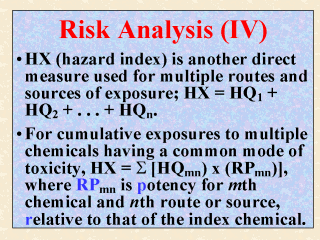| front |1 |2 |3 |4 |5 |6 |7 |8 |9 |10 |11 |12 |13 |14 |15 |16 |17 |18 |19 |20 |21 |22 |23 |24 |25 |26 |27 |review |
 |
In addition to
the MOE (margin of exposure) and HQ (hazard quotient) discussed in the last slide, another
direct risk measure often used is HX (hazard index). HX is used to account for multiple
routes and sources of exposure. It is defined as the sum of all relevant HQi,
where i denotes the ith route or source. That is, for exposures to multiple
routes and sources to be considered insignificant, HX = HQ1+ HQ2 + .
. . + HQn should be 1 or less. The last slide also stated that MOE = (SF)/(HQ), or HQ = (SF)/(MOE), where SF is the safety factor used to derive the reference dose RfD. This equality asserts that HX = (SFHX)/(MOEHX) = (SF1)/(MOE1) + (SF2)/(MOE2) + . . . + (SFn)/(MOEn). If SFi is the same for all routes and sources considered, then the overall MOEHX = [1/(MOE1) + 1/(MOE2) + . . . + 1/(MOEn)]-1. Where cumulative HX or MOE, rather than aggregate HX or MOE, must be considered, the overall MOEcum or HXcum can be computed similarly as above, provided that the potencies of the other multiple chemicals (those having a common mechanism of toxicity) are adjusted to that of the index (I) chemical. This provision is necessary so that the exposures to the multiple chemicals can be weighted by their relative potency (RP). The index chemical's potency is typically set to 1. And the RP for the other chemicals are each defined as: RPother = (PoDI)/(PoDother), where the point of departure PoD is the lowest level at which some degree of adverse effect of concern is seen or expected (see USEPA, 1999a, 2000b for further elaboration on the above derivations of aggregate and cumulative MOE or HX). |